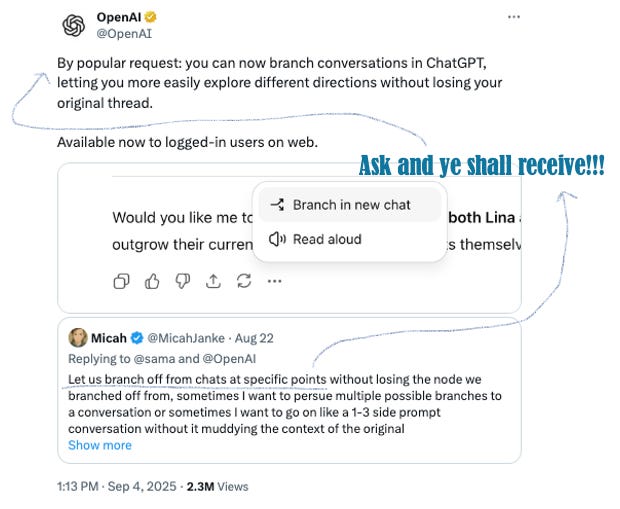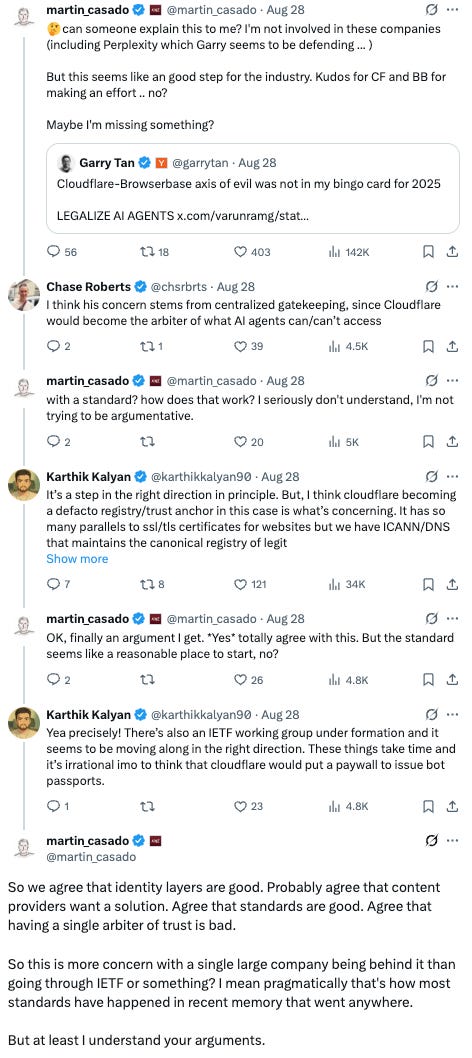When I look at all the news from this week, the theme crystallizes quickly: it’s all about interfaces and incentives. Interfaces are shifting where work actually happens (the browser), and incentives are shifting around who gets access (skills credentials, enterprise features… and very large checks 💰). And layered on top is something deeper: as the AI ecosystem matures and agent technologies proliferate, we’re now running into the same questions that shaped the early internet: who sets the standards, who enforces them, and how much centralization we’ll tolerate in exchange for safety and scale.
It wasn’t a particularly flashy week of announcements, but nonetheless very interesting. These are the structural moves underpinning the tectonic platform shift that is modern AI; and they will change how builders build, how enterprises buy, and how the “open web for agents” might take shape.
Let’s get into it!
Mistral makes enterprise features free — a direct shot at SaaS paywalls
Mistral’s Le Chat now includes enterprise-grade features at no cost (memory, connectors, team/workspace UX), explicitly positioning against gated enterprise tiers from incumbents. Call it a pricing missile aimed at the mid-market CTO who wants to standardize without per-seat sprawl.
Implications:
Vendor mix: security and governance will still decide a lot, but “free with enough control” will force pilots, especially outside the U.S.
Unit economics: if “good enough” knowledge work features are free, expect incumbents to push value up-stack (vertical workflows, compliance, SLAs) or sideways (bundles).
MEMORY PORTABILITY!!!! This is huge!!! Consumer lock-in due to memory is a real thing; if they can actually port memories from ChatGPT, that opens up a lot more competition for consumers as stickiness is greatly reduced!
Capital behind the move: reports also say Mistral is finalizing a €2B round at ~$14B post, which helps subsidize this aggression.
OpenAI turns skills into a product: Jobs Platform + Certifications
I’m just watching these foundation models go more and more vertical! Seems like now we’re competing directly with Linkedin. But it’s for a good cause!!
OpenAI outlined a workforce push: an OpenAI Jobs Platform to match AI-fluent workers with employers, and OpenAI Certifications delivered inside ChatGPT, with a target of 10 million Americans certified by 2030. Launch partners include Walmart, BCG, Accenture and others; there’s also a supporting “Jobs in the Intelligence Age” brief that explains the skills thesis.
Why this is a smart layer: Chat is a distribution beachhead; credentials and job matching turn usage into economic outcomes. For enterprises, this narrows the gap between “we’re training people on prompts” and “we can hire against a recognizable skills signal,” which has been missing so far. Also, this is just plain common sense for society writ large. If we are worried about jobs impact, let’s start reskilling everyone asap! Teach everyone how to fish, yada yada. I’m super skeptical of UBI as the magic bullet so I’m glad to see AI companies take workforce reduction potential seriously.
Generative audio goes long-form: Microsoft VibeVoice
Look at MSFT shipping! I’m totally here for this. Get ‘em, Satya!
VibeVoice (open-source, 1.5B and 7B) targets long-form, multi-speaker TTS – think 60–90 minute podcasts with expressive turns. The code/docs are live here.
Why it matters: long-form narration and instructional audio are now a local(ish) capability for product teams. Expect fast experiments in training content, accessibility, and agent “voices” that persist across sessions. If coding has solidified itself as the killer use case of the past 24 months, I’d say voice is on its way there in the last year. So much low hanging fruit for voice AI to be effective and provide ROI for a multitude of different companies.
From a single photo to an explorable scene
Tencent’s HunyuanWorld-Voyager produces 3D-consistent video sequences with depth from one image; you can “walk” short paths through the scene. It’s not full mesh-quality 3D or physics, but it’s a meaningful step for VR/AR prototyping and quick spatial storyboards. Ars has a good technical overview (RGB-D sequences, limits on realism and duration).
I keep thinking this is such an opportunity for retail though I have yet to see many real-life experiments with AI when shopping. (among my many random passions, I actually do quite like fashion… and yes in case you’re wondering, which you probably aren’t but since it’s my blog I can write whatever I want, I do stand out like a sore thumb in pretty much every San Francisco setting, so let this be my plea that we don’t all need to only wear vests and On running sneakers to dinner!!!!).
Content and e-commerce teams now have a cheaper way to preview spatial experiences (showrooms, training vignettes) without full scene capture. The realism bar isn’t there yet for simulation, but I think we can see where the industry could be going. I suppose the other obvious application for 3D video sequences one-shotted from an image is also a great opportunity for gaming, but given the only game I play is chess, I’ll refrain from pontificating 🙃
Talent turbulence at Meta
Sucks to be Zuck! Imagine paying hundreds of millions for researchers only to have it be a revolving door. Eeeek! Reporting points to swift exits and threats to leave among high-profile AI hires as Meta pushes its “superintelligence” effort.
Honest question: after all that “missionaries will beat mercenaries” spiel from Sam Altman, it’s pretty ironic that they’d just take them all back. Looks like everyone’s a missionary when it suits, and a mercenary when we are mad! 🙄
ChatGPT gets branching — real version control for conversations
UX improvements FTW!! I love when companies pay attention to customer feedback. OpenAI added Branch conversations on web: hover any message → “More” → Branch in new chat. It’s a small UI change with big workflow consequences: parallel explorations, cleaner audit trails, and easier A/Bs on prompts without polluting the original thread. It’s live now for logged-in users; OpenAI posted the announcement on X, and it’s noted in the official release notes.
Why it matters: Teams who actually work in ChatGPT can now fork ideas the way they fork code or duplicate slides. This is great for enterprises to see 1) better internal governance (each branch is a reviewable artifact) and 2) faster iteration on analysis/content/code workflows. Love!
Here’s my bet for what’s coming next, given the extreme reactions in comments: PINNING CHATS! (clearly people feel very strongly lol!)
Deals and dollars 💵
I normally don’t cover fundraising as much here (I will refer you to Chief AI Office for daily AI funding news), but given this week had some big money spender vibes, so here’s what I most paid attention to deals-wise:
Anthropic closed $13B Series F at $183B post (ICONIQ + Fidelity + Lightspeed). That’s fuel for product push (Claude Code, memory, context) and continued safety/security research.
Mistral is nearing ~$14B with a new round (per reporting and already mentioned above in the Le Chat section), reinforcing the Europe power center narrative while they weaponize pricing. Also sidenote - how many more billions will these AI companies keep raising at! Wowza!! The post-moneys just keep on climbin’!
Atlassian × The Browser Company is $610M cash (OMG, an acquisition that isn’t a reverse acquihire! How novel!!!), and it’s about owning the agent surface where tickets, docs, and dashboards already live. I think this take from Next Word was pretty solid, in case you, like many others, were left scratching their heads at this somewhat strange combo.
Last parting thoughts: An open web for agents?
Weeks are most fun when there’s some twitter/X drama! (errrr, nooo, just kidding, I love peace, I didn’t pull out the popcorn at all, noooo 😂)
This all started when late last week, Browserbase announced a partnership with Cloudflare:
Which was then followed by strong condemnation by Garry Tan:
And a thoughtful exchange on the thread:
Okay - why did I just share all these screenshots? Because access and control have been on my mind, ever since I wrote this piece when the news first broke of larger companies rate limiting their APIs and “gatekeeping” their customers’ data from AI agent companies.
As the AI ecosystem matures, and as agent technologies proliferate, we’ll be facing many of the same questions that defined the early internet: who sets the standards, who enforces them, and how much centralization we’re willing to tolerate in exchange for safety and scale. This initiative and ensuing exchange are a great example of what I imagine will be more and more common initiatives and questions to establish the agent web.
Ok Thx Jess, But What’s Actually Being Proposed?
Cloudflare and Browserbase are introducing a standard for authenticating agents (“Web Bot Auth” / “Signed Agents”). The idea is similar to SSL/TLS in the early web: give websites, APIs, and platforms a way to tell whether they’re dealing with a legitimate actor (a useful bot, app, or agent) versus spam, fraud, or abuse. Instead of bluntly blocking traffic at the network layer, this moves detection and control to the application layer — letting operators distinguish which agent is misbehaving rather than cutting off entire providers.
I don’t think this is DRM. It’s identity and trust infrastructure for agents, which candidly I think is necessary if they’re going to interoperate at scale.
Why Some Are Concerned
The worry is centralization. If Cloudflare (or any single player) ends up defining what counts as a “legitimate” agent, the open internet could tilt toward control by a few infrastructure giants. That’s the subtext of the criticism: whoever controls the root of trust effectively shapes the trajectory of agent-to-agent interaction.
Why Others Defend It
The counterargument is that this is plumbing, not gatekeeping. Without some shared identity layer, agents will be unreliable and easily exploited. Standards like TLS once felt like control, but in practice unlocked trillions of dollars in online commerce. Web Bot Auth could enable:
Safer agent-to-agent delegation
Protection against abuse without blunt over-blocking
Broader interoperability and trust
My Take
Both sides have merit, though I lean toward the defender side. Yes, history is full of “open standards” that entrenched whoever administered them, so skepticism is warranted. But the need for identity is unavoidable: without it, spammy and malicious agents will overwhelm legitimate ones. As Martin Casado well put it, identity layers are good, standards are good, and content providers probably do want a solution to this.
And yes, a single arbiter of trust is bad. So the real question is governance. If this becomes a closed or de facto monopoly standard, critics will be right to call it gatekeeping. If it’s open, interoperable, and portable across providers, it could become the foundational trust layer that makes the agent economy viable — just as TLS did for internet commerce.
We don’t get to choose between identity or no identity. We only get to choose whether it’s open or captured.












